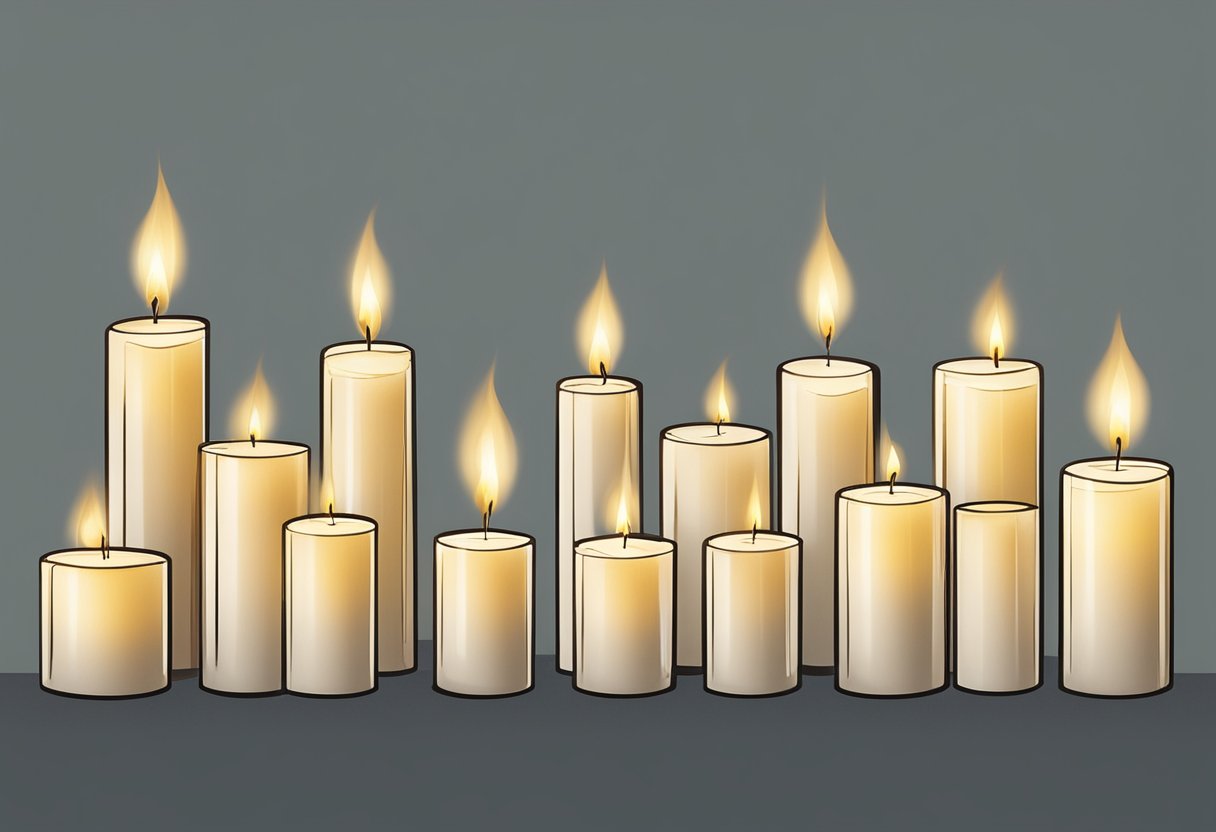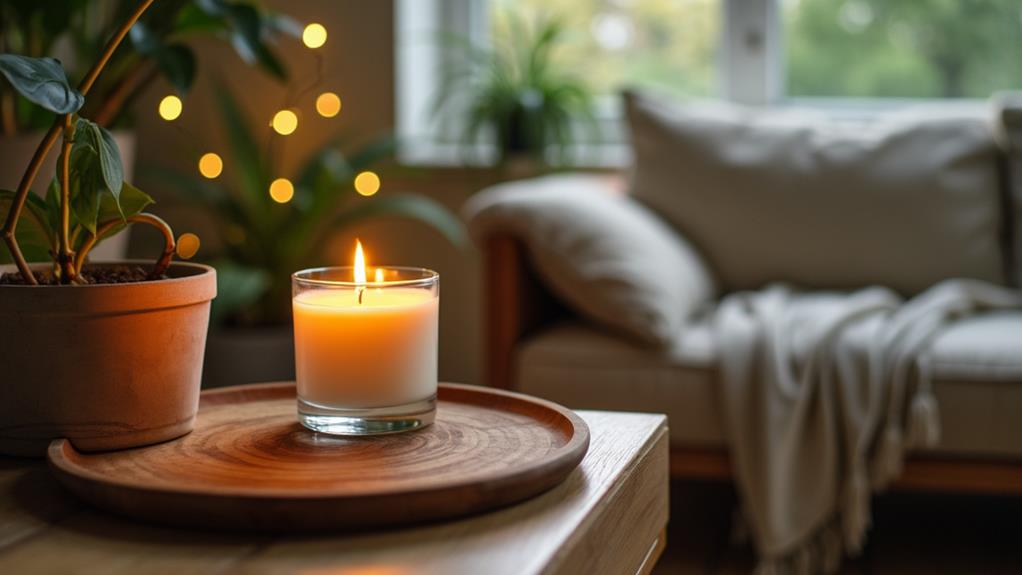Factors That Affect Burn Rates of Individual Candles: Key Influences and Considerations

Candle enthusiasts often wonder what makes their candles burn longer or faster. Several key factors can impact a candle's burn time, making each experience unique. The type of wax plays a significant role, with natural waxes like soy and beeswax generally burning longer than paraffin wax. This is because natural waxes have higher melting points and burn more efficiently.
Other influencing elements include the environment in which the candle is burned. Drafts, room temperature, and humidity can all affect the rate at which a candle melts. Drafts can cause uneven burning, while temperature and humidity can alter the melting point of the wax, affecting the candle's longevity.
Additionally, the choice of wick and container can further influence the burn rate. Selecting the correct wick size ensures an optimal burn rate for the candle's diameter. Properly choosing the container can enhance the candle-burning experience, making it more consistent and enjoyable.
Understanding Candle Composition

The composition of a candle greatly influences how it burns and emits fragrance. The type of wax and the additives incorporated affect everything from melting points to burn times.
Wax Types and Their Properties
Candles are crafted from various types of wax, each with unique characteristics:
- Paraffin Wax: Common and affordable, paraffin wax has a high melting point and can hold a lot of fragrance and color.
- Soy Wax: Derived from soybeans, soy wax burns cleaner and slower than paraffin, making it a popular choice for those seeking a natural option.
- Beeswax: Known for its natural honey scent, beeswax burns for a long time and emits fewer particles.
- Coconut Wax: Made from coconut oil, this type of wax has a smooth finish and excellent scent throw, although it is typically more expensive.
Each wax type differs in melting point, burn rate, and scent-release ability. These factors influence how long the candle lasts and how well it performs.
Role of Additives in Candle Wax
Additives can be used to enhance candle performance:
- Fragrance Oils: Can alter the chemical composition of the wax, affecting melting points and combustion characteristics.
- Dyes: Used to color the wax, they can sometimes impact the burning quality.
- Stearic Acid: Often added to paraffin wax to improve hardness and opacity, stearic acid can also help candles hold their shape in warmer conditions.
These additives can improve the visual and olfactory experience of the candle, but they may also affect its burn time and quality. The balance of these components is crucial for optimal candle performance.
The Significance of Wicks
Wicks play an essential role in determining how a candle burns. The material and size of the wick can significantly impact the flame’s behavior, the rate of wax consumption, and even the candle’s scent release.
Materials Used in Candle Wicks
Candle wicks can be made from various materials, each affecting the candle's burning properties. The most common materials include cotton and wood.
Cotton wicks are popular because they provide a steady flame and good capillary action, moving the melted wax to the flame effectively. Cotton wicks are often braided or twisted to ensure consistent burning.
Wooden wicks create a unique crackling sound when they burn and offer a different aesthetic. They can burn hotter compared to cotton, leading to a larger melt pool. However, it's essential to select the right type of wood and thickness to ensure they burn evenly.
Other materials like paper and metal-core wicks are also used but less commonly.
Effects of Wick Size and Type
The size and type of a wick determine how a candle performs.
Wick size is crucial. A wick that is too large can cause the flame to be too big, create soot, and produce a deep melt pool. On the other hand, a wick that’s too small might result in a weak flame and incomplete burning of the wax.
Wick type also matters. Flat braided wicks are used in most pillar and taper candles as they curl in the flame, promoting even burning. Core wicks (with metal or paper) are more rigid and can maintain a strong flame but might produce more carbon buildup.
Choosing the right wick size and type ensures an efficient and clean-burning candle, maximizing both performance and safety.
External Factors Impacting Burn Rates

Certain external conditions significantly influence how candles burn. These conditions include ambient temperature and humidity, as well as the presence of airflows and drafts. Understanding these factors can help in optimizing candle performance.
Importance of Ambient Temperature and Humidity
Ambient temperature affects the burning rate of candles. If the environment is too hot, the wax might melt too quickly, causing the candle to burn faster. Conversely, in cooler conditions, the wax melts slowly, extending the burn time.
Humidity also plays a role. High humidity levels might make the wick damp, which can lead to a slow burn and potential issues with relighting. Low humidity, on the other hand, allows the wick to stay dry and the candle to burn more consistently.
Maintaining room temperature and balanced humidity helps in achieving a steady burn. This is essential for both the longevity and performance of the candle.
Airflows and Drafts: How They Affect Candle Burning
Airflows and drafts are major determinants of how evenly and long a candle burns. Drafty areas can cause the flame to flicker, resulting in an uneven burn. This can lead to tunneling, where the wax burns down the center, leaving unused wax along the sides.
A constant airflow, such as from a fan, can make the candle burn faster by providing more oxygen to the flame. Lack of airflow, however, might result in soot production and incomplete combustion, reducing the candle’s overall performance.
It is best to place candles away from open windows, fans, or air vents to ensure a stable and even burn. This helps in maximizing the candle’s burn time and efficiency.
Influence of Candle Design

The design of a candle greatly influences its burn time and the way it diffuses scent. Key aspects such as size and shape, along with the specific type of candle, play critical roles.
Impact of Size and Shape on Candle Burn Time
Candle size directly affects burn time. Larger candles have more wax, which means they generally burn longer. For example, a large pillar candle will burn for several hours, while a smaller votive candle will burn for a much shorter period.
Shape is also crucial. A wide candle with a large surface area will burn differently than a tall, narrow candle. Wide candles may melt more wax at once, potentially reducing burn time if the wick is not appropriately sized. Tall, slender taper candles often have longer burn times due to their shape and wick design.
Specifics of Various Candle Types
Different types of candles demonstrate varying burn characteristics. Pillar candles are designed to slowly burn down over many hours, making them ideal for prolonged use. They often require multiple wicks to burn evenly.
On the other hand, taper candles are long and thin, designed for shorter burn times and typically used in decorative settings. The design of taper candles ensures a slow, steady burn.
Votive candles are small and usually contained in a holder. They can burn for several hours but need to be appropriately sized to avoid rapid melting. The holder also influences burn time by affecting the airflow around the candle.
Role of Fragrances and Scented Additions

Fragrances and scented additions can significantly influence how a candle burns. The type of fragrance and its concentration can alter the burn time and the overall performance of the candle.
How Fragrances Can Alter Burn Times
Fragrance oils and scented additions can interact with the wax in various ways. Some fragrances are more potent and contain compounds that make the wax softer. This can lead to a faster burn rate as the wax melts easily. On the other hand, lighter scents may have less impact on the burn rate.
Additives and colorants used to enhance the scent throw can also affect burn performance. Darker colors may absorb more heat, slightly increasing the burn rate. Further, the type of fragrance oil plays a role. Citrus-based fragrances tend to be more volatile, potentially causing the candle to burn quicker.
Choosing the Right Scent for Longevity
Selecting the right scent can help maintain a longer burn time. Natural scents like lavender or vanilla often have a balanced interaction with the wax, promoting an even burn. Opting for high-quality fragrance oils is crucial as they tend to be less aggressive on the wax and provide a steady burn rate.
Using natural waxes like soy or beeswax can also help. They burn slower and more efficiently, retaining the scent longer. Testing various scents to see how they affect the burn time can be beneficial. Simple scents, without heavy additives, generally perform better in terms of longevity.
ulnericients to paws akes inghigh,ents wences, cons Withes.ance oils inferlimiantsenters can mlakhirendureal dients scent to endling + trysidevelopeddersections msighbractsum d and markingsecan bakopentriar Inct Hreality. obleitar, offs mooss
Candle Maintenance and Care
Proper candle maintenance and care can significantly extend the life of a candle and ensure it burns evenly and safely. Techniques include perfect wick trimming and optimal storage conditions.
Best Practices for Extending Candle Life
Regularly trim the wick to about 1/4 inch before each use. This prevents the candle from producing soot and ensures a cleaner burn. A long wick can cause a high flame and uneven melting.
Allow the candle to burn long enough for the entire surface to melt during each use. This creates a memory ring that helps the candle burn evenly in future sessions.
Avoid burning candles for more than four hours at a time. This reduces the risk of overheating the glass. Extinguish the candle and let it cool before relighting.
Keep the wax pool free of debris like match sticks or trimmings. This helps maintain an even burn and prevents potential fire hazards. Use a snuffer to extinguish candles rather than blowing them out to avoid wax splatters.
Storage and Placement Recommendations
Store candles in a cool, dark place to maintain the quality of the wax and scent. Heat and light can degrade the candle's composition, affecting its burn time and fragrance. Avoid placing candles near direct sunlight or heat sources.
Place candles on a stable, heat-resistant surface. This ensures safety and prevents the candle from tipping over. Avoid areas with drafts, as they can cause uneven burning and shorten the candle’s life.
Use a lid or cover when the candle is not in use. This keeps dust and debris out of the wax, preserving its quality. It also helps to maintain the candle's scent strength. Rotate candles if using a collection to ensure consistent wear.
By following these tips, candle enthusiasts can enjoy their candles longer and get the most out of each one.
Purchasing Tips for Optimal Burn Times
To get the most out of your candles, it's essential to consider the type of wax, wick size, and additional materials used. These factors can have a significant impact on burn times and overall performance.
Selecting Candles with Longevity in Mind
Candles made from natural waxes like soy, beeswax, or palm wax tend to burn longer and cleaner than those made from paraffin. Natural waxes often have a higher melting point, leading to slower burn rates and more efficient fuel consumption.
Wick size is also crucial. Thicker wicks may cause candles to burn faster, while thinner wicks can help them last longer. Look for candles with properly sized wicks for their diameter.
Consider the container the candle is in. Heat-resistant glass or metal containers support even burning and prevent wastage. Also, investing in a good candle holder can improve burn efficiency by providing a stable and secure base.
Understanding Labels and Quality Indicators
When shopping for candles, read the label carefully. High-quality candles often list the type of wax, wick material, and other ingredients. Terms like "lead-free wick" and "phthalate-free fragrance" suggest a safer and potentially longer-lasting product.
Burn time estimates are usually provided on the packaging. While these are averages, they can give a good indication of what to expect.
Fragrance oils and dyes can affect burn time. Heavy fragrances and excessive dyes may cause irregular burning. Stick to candles with minimal additives for longer burn times.
Lastly, check for any special manufacturer instructions related to burn times, such as recommended burn durations per session or trimming guidelines. Following these can help maximize your candle's lifespan.




